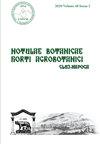Effects of harvest date on plant growth parameters and fruit phytochemical contents in different cultivars of chokeberry
IF 1.3
4区 生物学
Q3 PLANT SCIENCES
引用次数: 0
Abstract
Chokeberry, a type of berry fruit, has garnered attention in recent years due to its remarkable antioxidant properties. The rich bioactive components found in its fruits have been found to exert positive effects on human health. In this research, the growth, yield, and quality of two chokeberry cultivars (‘Nero’ and ‘Viking’) were evaluated, along with detailed biochemical parameters of the fruits, across different harvest dates ranging from mid-August to mid-September. During the experiment, it was observed that the ‘Viking’ cultivar exhibited more upright and taller plant growth than ‘Nero’. There were no significant differences observed between the cultivars in terms of yield, total soluble solids (TSS), total phenolic content (TPC), total monomeric anthocyanins (TMA), and antioxidant activity. However, ‘Nero’ demonstrated superiority in phenolic acids (excluding ferulic acid), glucose, citric acid, quinic acid, and ascorbic acid content. As the harvest progressed from August 31 to September 15, there was an increase in the accumulation of fruit TSS, TPC, TMA, sucrose, glucose, fructose, sorbitol, epicatechin, neo-chlorogenic acid, caffeic acid, chlorogenic acid, and ferulic acid. Harvest dates did not impact antioxidant activity and anthocyanin compound values. Among the taste-related compounds, sorbitol was determined to be the most abundant, while sucrose exhibited a positive correlation with all individual sugars. Additionally, malic acid and quinic acid showed a positive correlation. The combination of the ‘Nero’ cultivar and the September 15th harvest date stood out as the most prominent in superior fruit bioactive compounds.采收期对不同品种蔓越莓植株生长参数及果实化学成分的影响
蔓越莓是一种浆果类水果,近年来因其显著的抗氧化特性而备受关注。在其果实中发现的丰富的生物活性成分已被发现对人体健康具有积极作用。在这项研究中,研究人员评估了两个樱桃品种(' Nero '和' Viking ')在8月中旬至9月中旬不同采收期的生长、产量和品质,以及果实的详细生化参数。在实验中,人们观察到“Viking”品种比“Nero”表现出更直立和更高的植物生长。品种间在产量、总可溶性固形物(TSS)、总酚含量(TPC)、总单体花青素(TMA)和抗氧化活性方面无显著差异。然而,“尼禄”在酚酸(不包括阿魏酸)、葡萄糖、柠檬酸、奎宁酸和抗坏血酸含量方面表现出优势。从8月31日到9月15日,随着收获的进行,果实中TSS、TPC、TMA、蔗糖、葡萄糖、果糖、山梨醇、表儿茶素、新绿原酸、咖啡酸、绿原酸和阿魏酸的积累有所增加。采收日期对抗氧化活性和花青素化合物值没有影响。在与味觉相关的化合物中,山梨糖醇被确定为最丰富的,而蔗糖与所有单个糖都表现出正相关。苹果酸与奎宁酸呈显著正相关。“Nero”品种与9月15日收获日的组合在果实生物活性化合物中表现出最突出的优势。
本文章由计算机程序翻译,如有差异,请以英文原文为准。
求助全文
约1分钟内获得全文
求助全文
来源期刊

Notulae Botanicae Horti Agrobotanici Cluj-napoca
PLANT SCIENCES-
CiteScore
2.70
自引率
0.00%
发文量
118
审稿时长
3 months
期刊介绍:
Notulae Botanicae Horti Agrobotanici Cluj-Napoca is a peer-reviewed biannual journal aimed at disseminating significant research and original papers, critical reviews and short reviews. The subjects refer on plant biodiversity, genetics and plant breeding, development of new methodologies that can be of interest to a wide audience of plant scientists in all areas of plant biology, agriculture, horticulture and forestry. The journal encourages authors to frame their research questions and discuss their results in terms of the major questions of plant sciences, thereby maximizing the impact and value of their research, and thus in favor of spreading their studies outcome. The papers must be of potential interest to a significant number of scientists and, if specific to a local situation, must be relevant to a wide body of knowledge in life sciences. Articles should make a significant contribution to the advancement of knowledge or toward a better understanding of existing biological and agricultural concepts. An international Editorial Board advises the journal. The total content of the journal may be used for educational, non-profit purposes without regard to copyright. The distribution of the material is encouraged with the condition that the authors and the source (Notulae Botanicae Horti Agrobotanici Cluj-Napoca or JCR abbrev. title Not Bot Horti Agrobo) are mentioned.
 求助内容:
求助内容: 应助结果提醒方式:
应助结果提醒方式:


